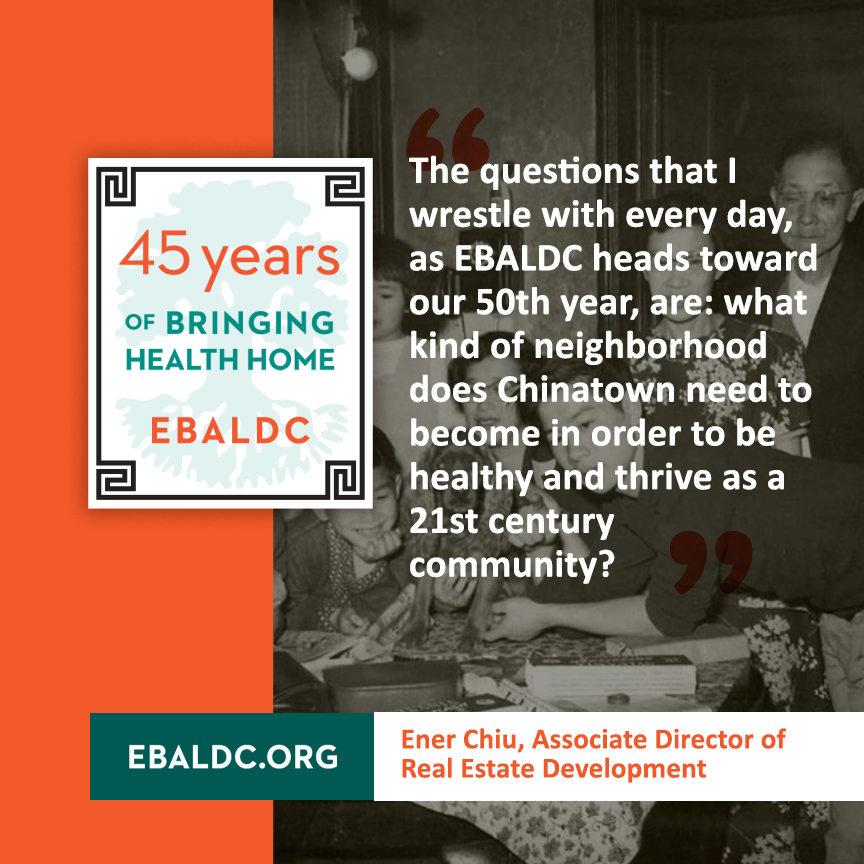One keeper, among many, of the Chinatown’s history

East Bay Asian Local Development Corporation
45 Stories for 45 Years
Contributor: Ener Chiu, Associate Director of Real Estate Development
I first learned of EBALDC in 2004 when I was in graduate school at UC Berkeley, and a young staffer named Tiffany Eng came to give a guest lecture to my community development class about the Individual Development Account (IDA) program that she had started at EBALDC. That summer, my fellowship sponsored an opportunity for me to intern at EBALDC, and Tiffany was my supervisor. I learned a lot about residential and commercial real estate development during that internship. When I graduated in 2005, Tiffany let me know that she would be leaving EBALDC to do IDA and real estate consulting work, and that I should apply for her job. I did apply, and eventually took over her former role as an Assistant Project Manager. I also moved into her condo just a few blocks from Chinatown, and progressed from being a housemate to a boyfriend, then later became a fiancé, and then a husband. Our children grew up going to EBALDC sponsored community engagement meetings and holiday parties, walking our dog to Jack London Gateway, going to daycare across the street from the Frank G Mar, and learning to ride bicycles in the Swan’s Market courtyard.
I was born to immigrant parents and lived the first few years of my life in New York City’s Lower East Side Chinatown, and I had the good fortune to marry into Tiffany’s family, which has been living and working in Oakland Chinatown since the early 20th century. They came to Oakland after being displaced by the 1906 earthquake and subsequent Great Fire in San Francisco, likely staying for a few weeks in a largely segregated Chinese American tent city along the estuary channel leading to Lake Merritt. They settled in the neighborhood east of core commercial Chinatown, lived through the flu pandemic of 1918 and the Great Depression, sent two generations of kids to Lincoln Elementary School, started a local optometry practice, and produced the first elected Asian American public official in Oakland. At one point after the war, four generations of their family lived close together in Oakland Chinatown. This family picture was taken in 1950, in the house where my father-in-law grew up, located at 8th Street and Fallon.

Chinatown in those days was a neighborhood for families. The community ties that bound together those generations were multilayered, and in many cases, they persist to the present day. But of course, it’s important that we also remember the context of these romantic, idyllic family photos. Ethnic enclaves like Chinatowns were not historically neighborhoods of choice; they were neighborhoods of necessity. Racist laws prevented Chinese and other minority groups from living in most areas of the city, so they settled here not only out of a desire to be close to their families and cultural institutions, but also for safety, and to make the best out of the few choices they had.
In the late 1950s and 1960s, major public infrastructure projects and social change disrupted the neighborhood. The 880 Nimitz Freeway cut a vast and relentless gash across many flatland neighborhoods. BART used eminent domain to take and demolish the house where that family photo was taken. Instead of naming the new BART station after the Oakland Chinatown neighborhood they had just dislocated and scarred, they named it for Lake Merritt. Laney College, Alameda County, and the Oakland Museum boxed in the neighborhood, even as the new freedoms afforded by the National Fair Housing Act allowed middle class Chinese American families to move outward into Oakland’s more suburban neighborhoods. The result was a Chinatown that was demographically older, and less economically stable.
This was the late 20th century Chinatown that EBALDC was founded in and grew up through. The questions that I wrestle with every day, as EBALDC heads toward our 50th year, are: what kind of neighborhood does Chinatown need to become in order to be healthy and thrive as a 21st century community? What from our past is important to preserve, or bring back, or strengthen? What is necessary to leave behind? And I know this: the answers to those questions are not simple, and the outcomes are not guaranteed. Left to the whims of 21st century hypercapitalism, Oakland Chinatown will eventually be erased by the shadow of glass and steel towers. EBALDC is critical to this community as a builder of safe harbors that can be shelters from that current. We are one keeper, among many, of the neighborhood’s history. We are part of the tangle of the place’s imperfections, contradictions, and beauty. And we are a vessel for the community’s optimism that people of all backgrounds and incomes can live, work, and play together in a safe and healthy neighborhood.
As EBALDC marks our 45th anniversary, we will be gathering more stories like this one from our friends, family, community members, partners and more stakeholders that have made our impact possible. We would be honored for you to join us:
- Follow us on social media: @EBALDC
- Visit us online to read the stories: ebaldc.org/category/45-stories
